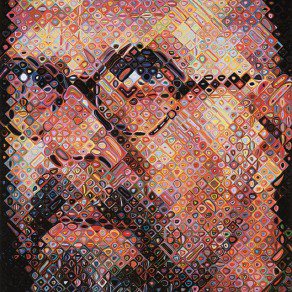27/1/2012
Chuck Close
Kunsthal, Rotterdam
Prints. Process and collaboration. On display 130 portraits created between 1972 and the present day in a comprehensive retrospective of Close's 'printed' works using various techniques such as mezzotint and spitbite etching, wood and lino cuts, textile and handmade pulp paper.

Since the 1970s, American artist Chuck Close (1940) has enjoyed international fame with his life-size photorealistic paintings. The Kunsthal is exhibiting 130 portraits created between 1972 and the present day in a comprehensive retrospective of his ‘printed' works using various techniques such as mezzotint and spitbite etching, wood and lino cuts, textile and handmade pulp paper. The portraits are based on photographs of himself, family and friends, and artists such as Philip Glass, Lucas Samaras and Alex Katz. His work combines traditional printing techniques and the latest technological innovations, with Close's recently produced photorealistic tapestries as the highlight. The result is a visual spectacle of modern portrait art in which the entire creative process can be followed, from concept to final version.
Cooperation
In 1988, Chuck Close became partially paralysed, but although he was forced to adapt his working methods, it did not obstruct his career. He worked on large projects in close collaboration with teams of craftsmen and engineers from all over the world. The combination of knowledge, experience and creativity that stemmed from this cooperation played an essential role for Close. His work is complex in structure, with some of his pieces requiring no less than 117 printing sessions and the manual printing process sometimes taking two years to complete. The grid is crucial and is an integral and visible aspect of Close's prints. The often large format makes his work appear abstract from close by, sometimes making faces unrecognizable. At the same time, his use of scale enlargement, irregularities and colour differences in the portraits (or ‘heads' as he calls them) influences the way we perceive them.
New Form of Expression
Close is constantly searching for new forms of expression and his experiments with printing techniques form an important part of his oeuvre. In his graphic work, he continually pushes the limits of the medium, for example in the portrait of his daughter, Georgia, in which he used pulp paper in various shades of grey. His fascination with portraits is partly due to the fact that he has difficulty in recognizing faces (face blindness). His work is not so much about the ‘heads' themselves, but rather the perception of them. Close's graphic work is innovative and has had significant influence on the generations that have followed him. Artworks by Close are included in many museums, including the National Gallery of Art (Washington DC), Museum of Modern Art (New York), the Guggenheim Museum (New York) and the Tate Gallery (London).
Kunsthal
Museumpark, Westzeedijk 341 - Rotterdam
Opening hours
Tuesday till Saturday: 10am-5pm
Sunday: 11am-5pm
Admission
Adults: € 11,00
CJP and students up to 26 years: € 5,50
Youth over 6 and under 18: € 2,-
Children under 5: free
Groups of at least 15 peoples: € 7,50 p.p.
Kunsthal membershipcard: free entrance for one year (individual card € 35,
partnercard € 65, familycard € 80)



